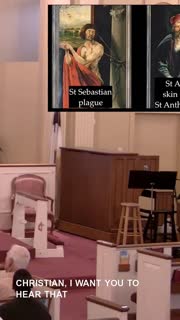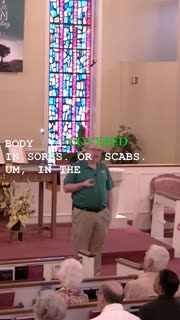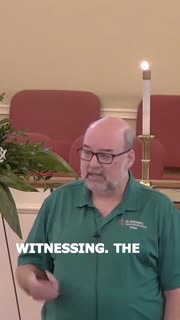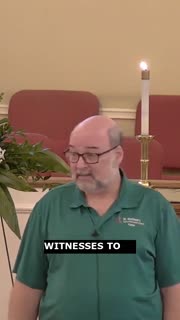Empathy, Witnessing, and the Call to Serve
Devotional
Sermon Summary
Bible Study Guide
Sermon Clips
### Quotes for Outreach
1. "It's those connections that will then kind of connect them to the church and ultimately hopefully prayerfully connect them to Christ as well and so that is our big our big push in this event well so happy that we'll be able to help kiddos get back to school with their haircuts in line and with all those other things that will be happening to school supplies as well but it's going to be a great event." [10:08] (24 seconds)
2. "Christian, I want you to hear that Christians were at work in the world. Creating hospitals to leave or to find, bring comfort to those who suffered great distress in these diseases. To the point, and that's why this piece was, was created to start with. Was to bring comfort to help people who were in those situations. Those healers and those families and those patients. This was the represent, representation of Christ. To give hope. To give comfort. To give peace to those who had none in their lives." [54:56] (36 seconds)
3. "The act of following Christ. Is completely counter cultural to any other that we would follow. What does the world teach? The world teaches that we follow the strong. The powerful. The healthy. The beautiful. Isn't that the message that we get from the world? The message of our faith is something completely different. The message of our faith says follow the one who is humble. Even unto death. The one who feels our pain. The one who has suffered our death. The one who walks with us." [01:05:22] (46 seconds)
4. "I'm happy pointing to Christ, who is the source of all of our life. For this reason, he says, my joy has been fulfilled. I've gotten all I need. Simply pointing to Christ. Simply witnessing to the one who brings life. He must increase. We've got to celebrate Jesus and the work of Jesus. And not celebrate ourselves. We must decrease. As we all become pointers. As we all become witnesses. To the one who makes a difference in this world." [01:07:43] (39 seconds)
5. "I'm so glad those Christians were there to bring healing and hope. To those with skin diseases. It brought danger to them that they might become infected. But they nonetheless stepped into that place where there was darkness to bring light. Stepped into that place where there was illness to bring healing. And commissioned one of the famous artists of the day to help bring comfort. To the folks who were sick and those who were bringing healing. By painting a masterpiece that says Christ is with us and Christ feels our pain." [01:08:44] (45 seconds)
### Quotes for Members
1. "Jesus' body is covered in sores. Or scabs. Um, in the painting, Matthias is given Jesus. The same skin disease that people there were suffering from. He's depicted him in that way. Uh, I think it's, he's trying to depict Jesus as one who, who sympathizes with those who are, who are hurt. The lost, the lonely, the least. Jesus joins with them in their suffering. So that they don't suffer alone." [55:52] (36 seconds)
2. "Witnessing. The act of witnessing means pointing in a specific direction beyond the self. And onto another. John's finger in this painting. Does not point in vain, but really indicates when and where. To see what he saw and heard. John is indicating the source of his life. Of his knowledge. The grace that he received. He's pointing to witness to the fact that it comes from Jesus. That it came from Jesus. And Barth is saying, and that's where we get our call as well. As we become witnesses. Not to point to number one. But to point to number one. Point to the one who is the source of our life." [01:03:36] (58 seconds)
3. "The act of following Christ. Is completely counter cultural to any other that we would follow. What does the world teach? The world teaches that we follow the strong. The powerful. The healthy. The beautiful. Isn't that the message that we get from the world? The message of our faith is something completely different. The message of our faith says follow the one who is humble. Even unto death. The one who feels our pain. The one who has suffered our death. The one who walks with us. Even when we're going through the chaos of plague. Or skin disease. Or anything else that might affect us. Or infect us." [01:05:22] (59 seconds)
4. "We decrease as we increase Christ. And that makes a difference in the world. We don't always know how. We don't always know why. Other than it's the love of God who desires that peace in the world. He's given us a faith so that we might follow him. Into those places where he would send us. And I pray that we always will." [01:09:50] (28 seconds)
5. "We are witnesses to the work of Christ in the world. We are pointers, not to ourselves. Not even really to St. Matthews. But to the one who works here. The one who brings healing. In the midst of whatever kind of plague or catastrophe or chaos might be reigning at the time. It's the one who brings life. It's the one that we witness to. Through everything that we do." [01:08:44] (33 seconds)
Ask a question about this sermon
1. "It's those connections that will then kind of connect them to the church and ultimately hopefully prayerfully connect them to Christ as well and so that is our big our big push in this event well so happy that we'll be able to help kiddos get back to school with their haircuts in line and with all those other things that will be happening to school supplies as well but it's going to be a great event." [10:08] (24 seconds)
2. "Christian, I want you to hear that Christians were at work in the world. Creating hospitals to leave or to find, bring comfort to those who suffered great distress in these diseases. To the point, and that's why this piece was, was created to start with. Was to bring comfort to help people who were in those situations. Those healers and those families and those patients. This was the represent, representation of Christ. To give hope. To give comfort. To give peace to those who had none in their lives." [54:56] (36 seconds)
3. "The act of following Christ. Is completely counter cultural to any other that we would follow. What does the world teach? The world teaches that we follow the strong. The powerful. The healthy. The beautiful. Isn't that the message that we get from the world? The message of our faith is something completely different. The message of our faith says follow the one who is humble. Even unto death. The one who feels our pain. The one who has suffered our death. The one who walks with us." [01:05:22] (46 seconds)
4. "I'm happy pointing to Christ, who is the source of all of our life. For this reason, he says, my joy has been fulfilled. I've gotten all I need. Simply pointing to Christ. Simply witnessing to the one who brings life. He must increase. We've got to celebrate Jesus and the work of Jesus. And not celebrate ourselves. We must decrease. As we all become pointers. As we all become witnesses. To the one who makes a difference in this world." [01:07:43] (39 seconds)
5. "I'm so glad those Christians were there to bring healing and hope. To those with skin diseases. It brought danger to them that they might become infected. But they nonetheless stepped into that place where there was darkness to bring light. Stepped into that place where there was illness to bring healing. And commissioned one of the famous artists of the day to help bring comfort. To the folks who were sick and those who were bringing healing. By painting a masterpiece that says Christ is with us and Christ feels our pain." [01:08:44] (45 seconds)
### Quotes for Members
1. "Jesus' body is covered in sores. Or scabs. Um, in the painting, Matthias is given Jesus. The same skin disease that people there were suffering from. He's depicted him in that way. Uh, I think it's, he's trying to depict Jesus as one who, who sympathizes with those who are, who are hurt. The lost, the lonely, the least. Jesus joins with them in their suffering. So that they don't suffer alone." [55:52] (36 seconds)
2. "Witnessing. The act of witnessing means pointing in a specific direction beyond the self. And onto another. John's finger in this painting. Does not point in vain, but really indicates when and where. To see what he saw and heard. John is indicating the source of his life. Of his knowledge. The grace that he received. He's pointing to witness to the fact that it comes from Jesus. That it came from Jesus. And Barth is saying, and that's where we get our call as well. As we become witnesses. Not to point to number one. But to point to number one. Point to the one who is the source of our life." [01:03:36] (58 seconds)
3. "The act of following Christ. Is completely counter cultural to any other that we would follow. What does the world teach? The world teaches that we follow the strong. The powerful. The healthy. The beautiful. Isn't that the message that we get from the world? The message of our faith is something completely different. The message of our faith says follow the one who is humble. Even unto death. The one who feels our pain. The one who has suffered our death. The one who walks with us. Even when we're going through the chaos of plague. Or skin disease. Or anything else that might affect us. Or infect us." [01:05:22] (59 seconds)
4. "We decrease as we increase Christ. And that makes a difference in the world. We don't always know how. We don't always know why. Other than it's the love of God who desires that peace in the world. He's given us a faith so that we might follow him. Into those places where he would send us. And I pray that we always will." [01:09:50] (28 seconds)
5. "We are witnesses to the work of Christ in the world. We are pointers, not to ourselves. Not even really to St. Matthews. But to the one who works here. The one who brings healing. In the midst of whatever kind of plague or catastrophe or chaos might be reigning at the time. It's the one who brings life. It's the one that we witness to. Through everything that we do." [01:08:44] (33 seconds)










